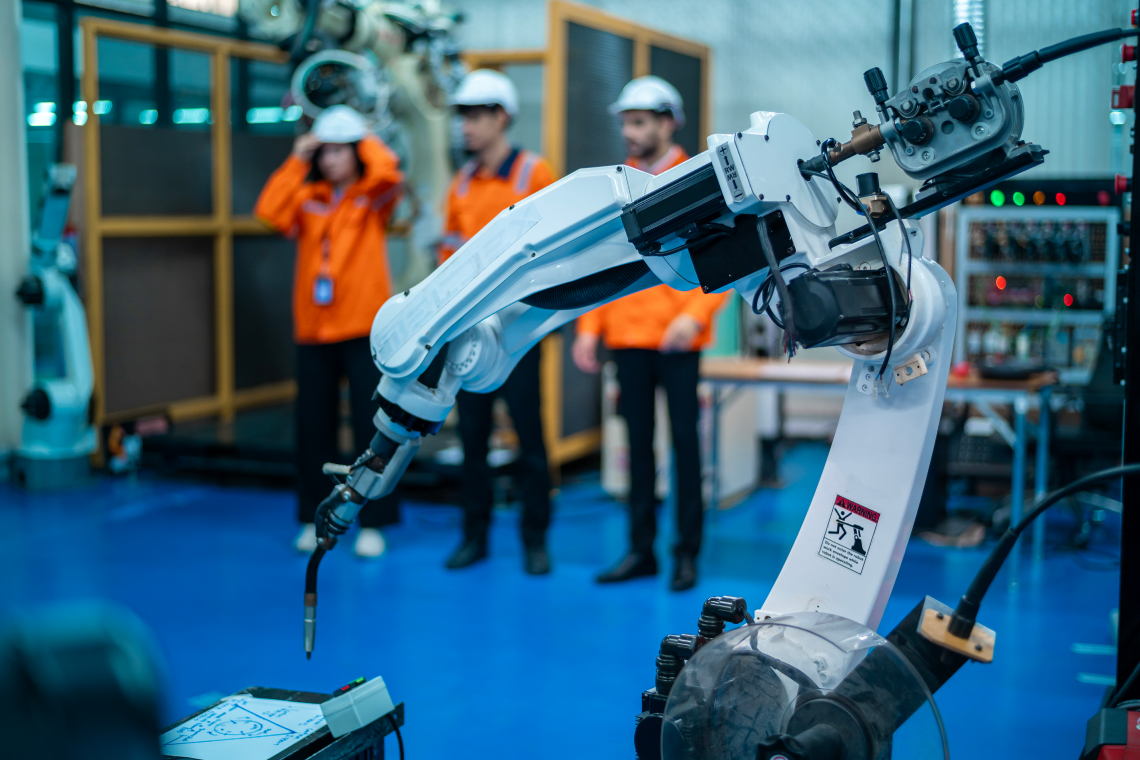Delta Robots and SCARA Robots are among the most widely used robots in industrial automation with the different advantages they offer. Knowing the differences between Delta Robot and SCARA Robot, both of which offer unique features and advantages, is very important for businesses to choose the most suitable robot for their production processes.
As Nilus Engineering, an engineering company that aims to bring its customers together with the latest technology services in the field of robot automation systems, in this article, we will talk about the differences between Delta Robots and SCARA Robots and which will be the right choice for you. Thus, you will be able to get the most suitable robot automation system parts for your industrial automation process and enjoy a smooth production process.
What are the Differences Between Delta Robot and Scara Robot?
Before moving on to the differences between Scara Robots and Delta Robots, perhaps it would be more accurate to mention the similarities. Both Scara Robots and Delta Robots are widely used in the field of industrial automation and both industrial robots are used in tasks such as high-speed material handling, assembly and packaging.
Despite these similarities, there are many differences between Delta robots and SCARA robots, primarily in performance-oriented features such as their design, mobility, load capacity and speed. Knowing the differences between Delta Robots and SCARA Robots will enable you to choose the most suitable industrial robot for your business.
Design Differences Between SCARA Robot and Delta Robot
SCARA Robots, which are called Selective Compliance Articulated Robot Arm in English and can be called Selective Compliance Assembly Robot Arm in Turkish, contain two connecting arms connected to the base by design. While they can perform their movements with high capacity in the X and Y axes, they are fixed in the Z axis. Due to their design, SCARA Robots can usually be mounted on the floor, ceiling or wall.
Delta Robots have three to four parallel connection arms. Their motors are mounted on the body, not on the connection points. This design feature allows Delta Robots to move faster than SCARA Robots. In addition, Delta Robots can only be mounted on the ceiling.
Delta Robot and SCARA Robot Payload Differences
SCARA Robots can experience higher payloads than Delta Robots. The payload capacity of most SCARA Robots ranges from 0.5 kilograms to 20 kilograms. For example, FANUC SR-20ia Model SCARA Robots have a payload capacity of 20 kilograms.
Delta Robots, on the other hand, cannot carry as much payload as SCARA Robots. The carrying capacity of Delta Robots is around 3 kilograms maximum.
Delta Robot and SCARA Robot Speed Differences
Delta Robots are superior to SCARA Robots in terms of speed. The fact that their motors are located in the body is the main reason behind delta robots being a faster industrial robot than SCARA Robots. For example, the FANUC M-1ia Delta Robot can operate at much higher speeds than SCARA Robots.
Delta Robot and SCARA Robot Mobility Comparison
SCARA Robots have full movement capability in the x and y axis, while they have a more limited movement capacity than Delta Robots in the z axis. Because Delta Robots can move in all x, y and z axes with full capacity.
Delta Robot and SCARA Robot: Which is the Right Choice?
Your choice between Delta Robot and SCARA Robot should be based on the specific criteria you are looking for in the production line. Both robots offer different advantages.
For example, Delta Robots are ideal for production facilities that require high speed. Delta Robots are frequently utilized in industries that require high speed in the production process, such as electronics and food.
However, if what you are looking for in your production processes is high carrying capacity, it would be more logical to choose SCARA Robots. SCARA Robots, which can be considered ideal especially for assembly and packaging processes, make a difference in processes that require precision and high carrying capacity.
In cases where your working space is limited, your preference should be in favor of SCARA Robots. This is because SCARA Robots provide a great advantage in terms of installation flexibility. While Delta Robots can only be mounted on the ceiling, SCARA Robots can be mounted on the floor, ceiling and wall.
Is Delta Robot or SCARA Robot Better?
In the world of industrial automation, Scara and Delta robots are two important robot types that are frequently used to speed up production processes and increase productivity. Both types of robots have their own unique features and advantages, so rather than saying which is “better”, it’s important to understand which applications they are better suited for.
In the electronics industry, Scara robots are frequently used for tasks such as placing components on circuit boards. The EPSON G20 Scara robot can reach speeds of up to 3 meters per second and carry payloads of up to 20 kg. This makes it possible to quickly and precisely place large amounts of electronic components.
In the food industry, for example in a chocolate factory, the IRB 360 FlexPicker delta robot can be used. This robot can perform 150 pick-and-place cycles per second, enabling it to quickly place chocolates into packages on the production line.
Scara robots have a higher payload capacity and are generally more accurate. For example, the Omron Adept Cobra 800 Scara robot has a repeatability accuracy of ±0.017 mm. This is ideal for precision assembly operations. On the other hand, delta robots are faster and have a larger range of motion in the three-dimensional plane.
Another advantage of delta robots is that they are more suitable for clean room applications. Because their motors are located in the robot body, they produce fewer particles in the workspace. This is important in the pharmaceutical and semiconductor industries. For example, the Kawasaki YF03N delta robot has ISO class 3 cleanroom certification and can be used in pharmaceutical production lines.
Scara robots, on the other hand, have a larger workspace and can be mounted on the floor, wall or ceiling. This flexibility is an advantage in factory layouts. The Yuki Precision YK1000XG Scara robot has a reach of 1000 mm and can be used in large workspaces.
From a cost perspective, Scara robots are generally more economical than delta robots. However, in high-speed applications, the increased productivity of delta robots can lead to cost savings in the long run.
In terms of robot programming, Scara robots are generally easier to program because they have a simpler kinematic structure. The complex parallel structure of delta robots may require more advanced programming skills. However, modern robot control systems have greatly reduced this difference.
As a result, there is no single answer to the question “Are Scara Robots or Delta Robots better”. The choice depends on the requirements of the application, factors such as speed, precision, load capacity, workspace and budget. Scara robots may be preferred for electronic assembly, precision machining and medium-weight loads, while delta robots may be more suitable for high-speed pick-and-place operations and applications in the food and pharmaceutical industries. Both types of robots have an important role in industrial automation and the right choice can significantly improve the efficiency and quality of production processes.
SCARA Robot and Delta Robot Price Comparison
In general, Scara robots are more affordable than Delta robots. However, this is not always the case and there may be differences between specific models. Factors affecting prices include the size of the robot, load capacity, speed, precision, brand and additional features.
The main reasons for price differences include the fact that Delta robots have a more complex mechanical structure and can generally operate at higher speeds. Also, Delta robots often need more precise control systems and more advanced software, which increases the cost.
On the other hand, Scara robots’ simpler mechanical structure and wider range of applications reduce their production costs and therefore make them more affordable. However, the prices of high-performance Scara robots can exceed those of some Delta robots.
Another important factor affecting prices is the robot’s payload capacity. In general, Scara robots have a higher payload capacity, which can affect their price. For example, a Scara robot with a 20 kg payload capacity can be more expensive than a Delta robot with a 3 kg capacity.
The speed of the robot is also an important factor affecting the price. Delta robots can usually reach higher speeds, which increases their price. However, the high-speed Scara robots developed in recent years can also be quite expensive.
The brand and manufacturer of the robot also significantly affect the price. Robots from well-known brands such as Fanuc, ABB, Yaskawa are usually more expensive. However, these brands also tend to offer more reliable products and better customer support.
When making a price comparison, it is important to consider not only the cost of the robot itself, but also the costs of installation, training, software and maintenance. In some cases, a more expensive robot may be more economical in the long run thanks to lower maintenance costs or a longer lifespan.
In addition, the application for which the robot will be used is also an important factor in price comparison. For example, a Delta robot may be preferred for high-speed pick-and-place operations, in which case the higher price may be offset by increased productivity. On the other hand, for precision assembly operations, the Scara robot may be more suitable and may benefit from its lower price.
When comparing the price of Scara and Delta robots, it is important to look not only at the initial purchase cost, but also at the total cost of ownership, the requirements of the application and the potential increase in productivity. While Scara robots are generally more affordable, the optimal choice for each situation may be different. To make the right decision, it is important to conduct a detailed cost-benefit analysis, get quotes from different suppliers and seek expert opinions.






